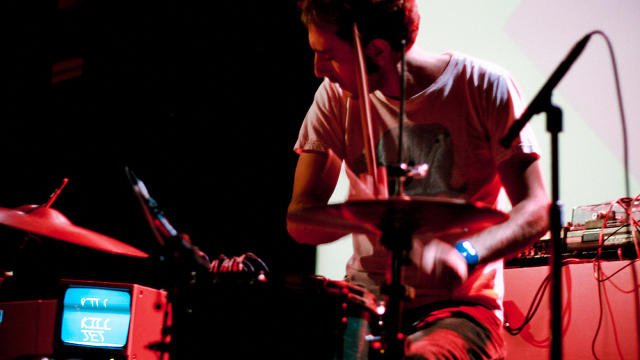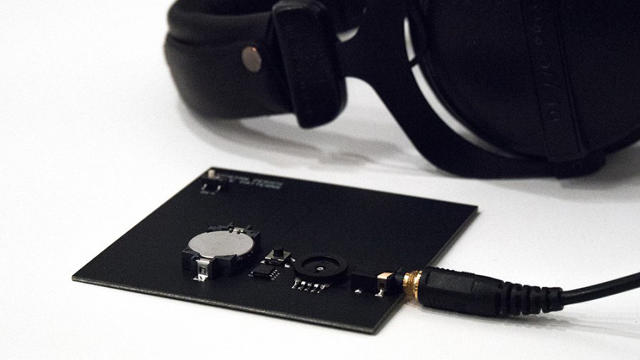The Album That Plays Itself
You don’t need an MP3 player, a turntable, or a CD player to listen to Tristan Perich’s new album, Noise Patterns. All you need is a pair of headphones—”not earbuds,” says the composer—and a willingness to hear music in noise.
The 34-year-old Perich’s compositions push the border between white noise and electronic music, frequently straddling the two as if the static on your old television started emitting a strangely beautiful pattern of sound. But Perich doesn’t just compose music: His music is the instrument itself. He composes sound in code, carefully stringing together each 1 and 0 to transform numbers into a symphony.

Perich, who studied math, music, and computer science at Columbia and received a masters from NYU’s fabled hacking-meets-art Interactive Telecommunications Program, has spent the last dozen years of his life exploring the frontiers of one-bit sound, transforming those lines of 1s and 0s into a living art form. With Loud Objects, a band with college friends Katie Shima and Kunal Gupta, Perich’s playful experimentation involved live circuit-bending—soldering the circuit in real time; on his own, Perich has delved deeper into code, and made three chip-based albums: 2007’s One Bit Music, 2010’s 1-Bit Symphony (an electronic symphony in five movements), and Noise Patterns, released in July.
Like the previous outings, Perich’s latest masterpiece is emblazoned on a limited-edition microchip and soldered to a circuit board so simple that it looks like it could be made out of Snap Circuits. Plug your headphones or speaker into the board’s tiny jack, turn the switch to “on,” and over six sections Perich’s cascading waves of “one-bit” sound fill your ears.
“One-bit music is electronic sound that’s created entirely with just on-and-off values,” says Perich, who grew up composing music for classical ensembles. Compare that to 16-bit sound, which is what is traditionally used on CD albums, where audio is digitally sampled at 44,100 samples per second and then quantized (that’s a physics term) into 16-bit quantities, each capable of representing 65,536 discrete loudness values. The fidelity of that CD sound is such that the difference between that sound and the original wave is almost imperceptible to human ears.
Strip that down by half and you get 8-bit sound, which is best known as “chiptune” or the soundtrack to early Nintendo and Game Boy games. “[At 8-bit], you start to get this electronic quality sound,” says Perich. There’s a cottage industry of musicians on YouTube and elsewhere remaking songs to achieve the sonic quality of the Super Mario Bros. soundtrack, but he wanted to take it a step further.
“I was interested in one-bit sound, which is going all the way down to its most basic digital representation of sound, where the soundwave is composed entirely of ones and zeroes, just on and off pulses of electricity. It’s basically the binary language of information translating directly into sound.”
A recorded excerpt from Noise Patterns:
The end result is music that is simultaneously highly technical and very primitive—with the hypnotic influences of Steve Reich and Lightning Bolt alike—as it makes a direct connection between code, software, data, noise, and sound. “It’s very raw and pure in my mind,” Perich says of the work. “It’s a conceptual aesthetic exploration of the nature of electronic sound.”
Perich is often trying to balance the visceral and aesthetic with the mathematical and conceptual. “My aim is to create music that can move back and forth between these different effects,” he says. “[There will be] a pulse or a rhythm that’s really easy to hold onto and could almost be like a dance track or something, and then slowly that will break down until you’re listening to something that’s very abstract and noisy and more like a wall of sound. But because of how you got there, you still hold on to the beat in your mind. You can see where these changes came from.”
“I’m trying to walk the listener through this process because the process itself is meaningful to me,” he adds, “the math behind the sound is meaningful to me.”

It would be easy to suspect that the noise emitted by Perich’s music machine is merely a mathematical potpourri made of random numbers, but it is in fact completely composed. “It’s fully written and I don’t use randomness in the process, which is to say it’s not an algorithmic piece of music,” says Perich. He composes and codes simultaneously, writing the music on a computer that is connected to a custom circuit board that he built. “That allows me to test the musical material the exact same way as it would play back on the album.”
Next, he distills his code into a “chip-ready version of the music” that he pairs with software he’s written specifically to synthesize the code and to sequence or play the music. All of the code must eventually fit within the confines of the chip’s 8,000 bytes of memory, about the size of three desktop screenshots. Perich took every byte he could.
The object itself is a handsome matte black machine-made printed circuit board with two barely visible strands of copper for the electricity to run through. A machine solders the components (chip, headphone jack, volume dial, on-off switch, and fast-forward button) onto the circuit board; underneath, an imperceptible layer of copper connects all of the ground pins of all of the parts, grounding the circuit and helping to reduce radio interference.
The board is returned from a factory in China to Perich, who then transfers his software to the chip directly from his computer, turning each circuit board, one by one, into what Perich describes as a “self-contained little computer.” The neat package is the epitome of plug-and-play technology, in that you simply plug in your headphones, switch it on, and you’re listening to his symphony.

Perich chooses the minimalist look for the project partly for its sleek aesthetic—it comes in a tidy CD jewel case with liner notes that contain the entire code—but also for a more instructive reason.
“I present the music as this raw circuit board so that you can actually trace the paths of electricity from the battery through the on-off switch back to the chip, and then you can trace the output of the chip to the headphone jack, and be part of that process as a consumer,” said Perich. “I want people to think about these things, especially in a time where technology is becoming more and more complex, more opaque, and we really don’t understand what’s happening on our phones or on our laptops or the servers that we’re connecting to for our social media and everything.
“I’m trying to at least give a hint at the fact that technology doesn’t need to be magical, it doesn’t need to be out of reach. It can be very simple.”

Because of the intensive assembly process, there are currently only 5,000 physical copies of Noise Patterns in existence. The album is streaming digitally, but the effect isn’t quite the same, partially because the streaming version is a recorded version of the album and misses some of the techno-romance of listening directly from the circuit board as it plays its prescribed tones. The online version also doesn’t afford the listener the distinct pleasure of fast-forwarding: Press the single black button once to skip to the next song, but hold it down, and you’re treated to an accelerated sequencing of the track at hand. The staticky thumps give way to ghostly bloops and the uncanny tremolo of a black helicopter.
Not that Perich particularly minds how you listen to his music, virtually or physically. “While I’m trying to make some commentary on how we listen to music by putting it out as a circuit board, I also don’t want to tell people how to listen to music,” he said. “If they want to hear it on their computer or on their phones, that’s absolutely fine by me.”
That pragmatism is typical of Perich. As often as he is invited to share his work in math, physics, and computer science classrooms, at heart he is very much a composer, building machines that build soundscapes. “At the end of the day,” he said. “It’s music, it’s just music.”
Fast Company , Read Full Story
(45)



